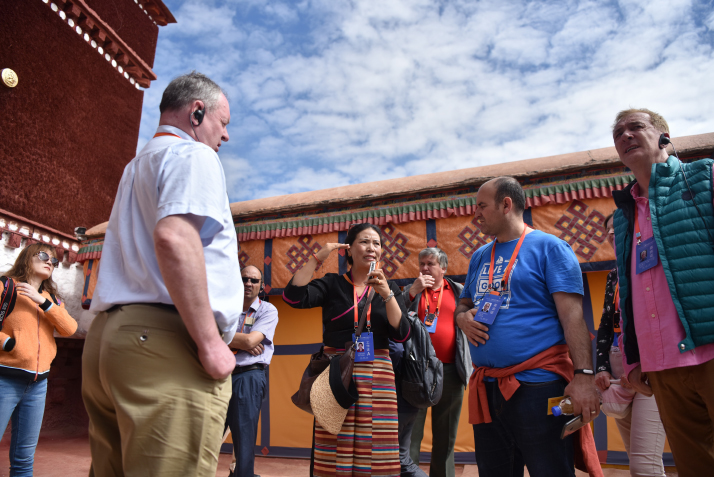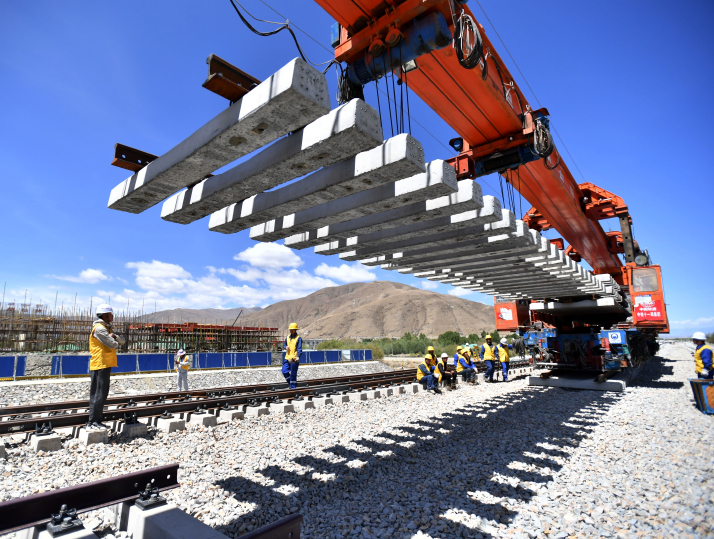|
||||||
|
||||||
| Home Nation World Business Opinion Lifestyle China Focus ChinAfrica Multimedia Columnists Documents Special Reports |
|
||||||
|
||||||
| Home Nation World Business Opinion Lifestyle China Focus ChinAfrica Multimedia Columnists Documents Special Reports |
| Nation |
| Window in the Southwest |
| Rich in historical legacies, fast-developing Tibet helps forge stronger connections with South Asia |
| By Sudeshna Sarkar · 2019-06-24 · Source: NO.26 JUNE 27, 2019 |
 A guide shows visitors around the Potala Palace in Lhasa, capital city of southwest China's Tibet Autonomous Region, on June 13 (XINHUA)
In Lobsang's sunny living room furnished with Tibetan-style intricately carved and painted wooden sofas, three items have pride of place. One is a certificate of merit from the People's Liberation Army where the 66-year-old served for seven years; the second is a photograph showing him attending a meeting with government officials in Beijing, wearing his traditional Tibetan jacket and hat. But it's the third object that catches the eye of visitors to the house of the richest man in Trashigang, a small village in Tibet Autonomous Region in southwest China. It shows an adorable little boy in the arms of a smiling visitor, surrounded by beaming villagers. The visitor is Xi Jinping, President of China. "President Xi visited our village on July 21, 2011," Lobsang said with pride. "My grandson was 3 years old at the time." Rapid development In a way, the photograph and the Lobsang family represent the rapid development in Tibet in the five decades since the autonomous region was founded in 1965. From an impoverished farmer's son who became a car driver and then started a transport and homestay business spurred by government policies for entrepreneurs, Lobsang turned to construction, and the boom in infrastructure made his business prosper. Today, he owns six vehicles and his annual income is about 400,000 yuan ($58,000). The photograph of his grandson in Xi's arms has become part of the region's archival records. It can be found at the exhibition in the No.2 Primary School in nearby Nyingchi City. Established in 1971, the school boasts extraordinary educational resources. Besides a playground with a first-class track and field, there are flat-screen computers and multimedia equipment in classrooms to make the lessons interesting and the children digitally attuned. The music rooms have an abundance of small pianos and the laboratories and art rooms are equally rich in paraphernalia. Visitors to the Museum of Natural Science in Lhasa, Tibet's capital city, will run into the photograph again if they visit the memorial hall on the upper level. Opened on March 28, the hall chronicles Tibet's important events including the abolition of serfdom in 1959 and the photo is there again as an image from the new era. The amazing videos in the hall using animated full-sized figurines and 3D cycloramas show the technological advancement. These were some of the developments showcased by the Forum on the Development of Tibet, China, held in Lhasa on June 14 and hosted by the State Council Information Office and the Tibet Autonomous Regional Government. The sixth session of the forum, this year's event focused on opening up the autonomous region as part of the Belt and Road Initiative. "Tibet will seize the opportunities for development… and conduct extensive international exchanges and cooperation," Xi said in a congratulatory message, highlighting Tibet's readiness to step up interaction with the rest of the world. As part of that, the autonomous region has beefed up its transport and communication network, said Qizhala, Chair of the Tibet Autonomous Regional Government. After the nearly 2,000-km Qinghai-Tibet Railway—Tibet's first railway and an engineering marvel that opened in 2006, connecting Lhasa with Xining, a city in Tibet's neighboring Qinghai Province—the second railway linking Tibet with other parts of China is in the works. The Sichuan-Tibet Railway will link Lhasa with Chengdu in southwest China's Sichuan Province, covering 1,700 km in 13 hours. There are five airports on the roof of the world, served by 10 airlines with 96 routes, while Tibet's road network has crossed 97,000 km. Cross-border connection Now the more ambitious plan is to extend connectivity across borders. As Vjaceslavs Dombrovskis, a member of parliament from Latvia and Chairman of the Group of Cooperation Promotion Toward China, said, "Development needs trade, and distance kills trade." To bridge the distance between China and its neighboring countries in South Asia, several multinational connectivity projects are on the anvil. One is a railway that will run from Xigaze, Tibet's second largest city, almost up to Kathmandu, capital of Nepal, Tibet's largest border trading partner. Once this arduous engineering feat through high-altitude, difficult terrain is accomplished, the plan is to extend the railway all the way to Nepal's southern border, close to India. China and India, two of Asia's largest markets, are common elements in several South Asian networks. China has proposed an overland economic corridor that would connect China, India and Nepal, said Wang Yanzhong, Director of the Institute of Ethnology and Anthropology at the Chinese Academy of Social Sciences. The China-Nepal-India Economic Corridor would build a multidimensional, tri-national network of dry ports, railways, roads, airports, electricity grids and telecommunications networks. Another connectivity project, the BCIM, is the blueprint of an economic corridor linking Bangladesh, China, India and Myanmar. Then there is the Himalayan Economic Rim that will connect dry ports in Tibet with Nepal, India and Bhutan. However, as Wang pointed out, infrastructure is expensive. Only when China and India are more deeply integrated, can the China-Nepal-India corridor make headway, he said. There lies the crux of the matter. According to the experts at the forum, a huge degree of mutual trust is needed to make the projects materialize. But in South Asia, they said this trust is missing, mainly between India and China, given their historical border spats. And this is where Tibet has a significant role to play. Tibet, once part of several trade routes like the overland ancient Silk Road and the ancient Tea Horse Road, was an important passage to South Asia. Traders and travelers carried famed Chinese products like tea, silk and porcelain and philosophies like Confucianism and Taoism to South Asia through Tibet, while South Asia sent local specialties and Buddhism, enriching each other and creating deep trade and cultural ties. "Tibet can be a platform to generate trust," said Octavio Ramos Lazcano, a former consultant with Mexico's Chamber of Deputies, its lower legislative house. According to Qizhala, Tibet will continue to build infrastructure, implement a one-stop clearance system to facilitate trade and investment, and promote cooperation in industries and e-commerce. The local government will help Chinese banks set up branches in other countries and banks from other countries to set up shop in Tibet.  Builders work on the Sichuan-Tibet Railway in Zhanang County, southwest China's Tibet Autonomous Region, on June 6 (XINHUA)
A green Silk Road Underpinning the opening up will be environmental protection and the development of clean energy, which can be exported to neighboring countries, creating a green Silk Road with a low-carbon economy. "The Himalayas have never been a barrier but a passage of friendship," Qizhala said. "If our hearts come closer, we won't be afraid of mountains and seas." While Tibet can play a key role in linking China with South Asian countries closer to build infrastructure, culture, healthcare and people-to-people links, the experts also pointed out the challenges. The most discussed one comes from climate change worldwide and its possible impact on Tibet's fragile environment. The government is aware of the danger and measures are being taken to protect the ecology of the world's last virgin land, especially the air, water, soil and green cover. According to data from the Chinese Academy of Sciences and environmental protection departments, Tibet is one of the regions with the best ecological conditions in the world, with most areas retaining their pristine state. Its large number of nature reserves, national forest parks and wetlands form an environmental protection network. Since 2001, the government has spent 31.6 billion yuan ($4.71 billion) on eco-compensation, such as compensating herders for not overexploiting grazing grounds, to conserve ecological reserves. Liu Yawei, Director of the China Program of the Carter Center in Atlanta in the U.S., raised a socio-political issue: the West's perception of Tibet. "Tibet has a population of less than 4 million but figures very large in global imagination," he said. "It has become a paradise in living conditions but that hasn't penetrated the Western mind. If the Western narrative of Tibet remains unchanged, Tibet can't play its role to the full." Copyedited by Rebeca Toledo Comments to yanwei@bjreview.com |
About Us | Contact Us | Advertise with Us | Subscribe
|
||
| Copyright Beijing Review All rights reserved 京ICP备08005356号 京公网安备110102005860号 |